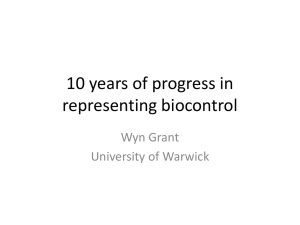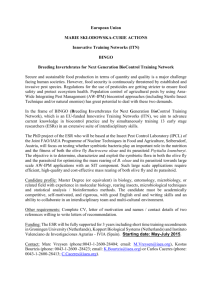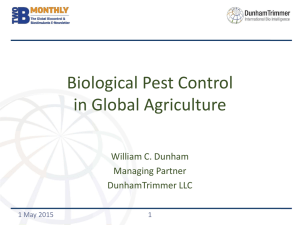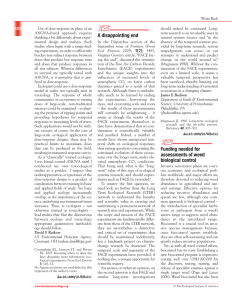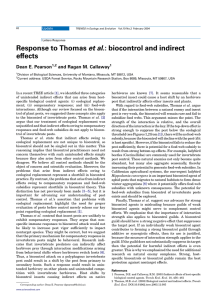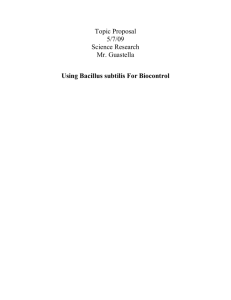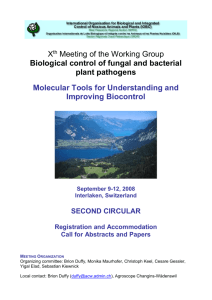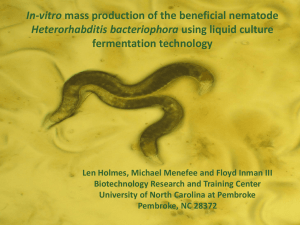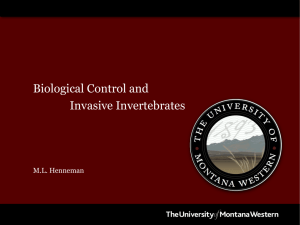Lecture 14 - Biocontrol
advertisement
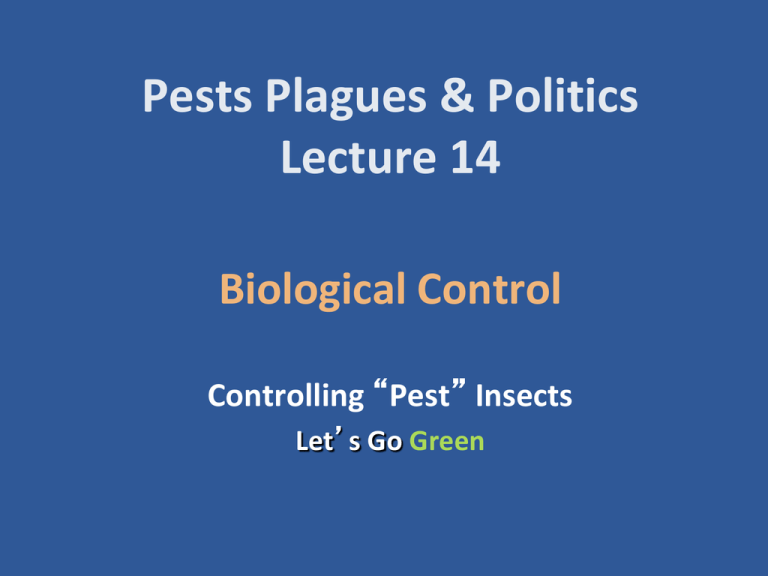
Pests Plagues & Politics Lecture 14 Biological Control Controlling “Pest” Insects Let’s Go Green Key points: Biological Control • Describe two key arthropod classes of biocontrol agents • What are the constraints of biological control • What are the advantages of biocontrol • Give other non-insect biocontrol agents The biggest enemy of an insect is another INSECT!! Bio-control is the use of a pest insect’s natural insect enemies for its control. Bugs eat Bugs 1) As direct predators* 2) As parasites & parasitoids* Predators: Ladybird adult Both are excellent predators Ladybird larva Photo’s: Ken Gray photo collection, OSU Asian weaver ant One of the earliest known insects as biocontrol agents http://en.wikipedia.org/wiki/Weaver_ant Mike Burgett Predation: A true bug, lunching on another true bug. Parasitoids: A fly parasitoid larva emerging from the host larva. Photo’s: Ken Gray photo collection, OSU A carpenter bee giving you the once-over A carpenter bee larva that has been parasitized by a wasp. Polyembryony has taken place and the bee larva contains many thousands of wasp larva Mike Burgett Mike Burgett Biological Control – Advantages* • • • • • Self-perpetuating Pest specific Density dependent Cost effective Environmentally compatible Biological Control – Constraints* • Not immediately effective (may take years) • Not eradicative (is this really a constraint?) • Biocontrol agents unknown for many pest species. • Doesn’t always work – Historically only one out of four attempts has been successful What makes an effective biocontrol “agent”?? • • • • High to complete prey specificity Multivoltine with respect to target species Well adapted to habitat of target species Excellent searching ability Lacewing immature at “lunch” Photo’s: Ken Gray photo collection, OSU Classic Biological Control “Control of an Exotic insect pest by the introduction of its natural enemies” • • • • • foreign exploration quarantine processing mass propagation field colonization (release) evaluation of impact 100 successes in the past 100 years!! Bugs on plants Tyria jacobaeae, Cinnabar moth http://en.wikipedia.org/wiki/Cinnabar_moth Preventing predation and enhancing biocontrol Bright colors of larvae/adults warning sign http://en.wikipedia.org/wiki/Cinnabar_moth http://ucce.ucdavis.edu/files/repositoryfiles/ca2404p12-63742.pdf Tansy ragwort flea beetle. Prevents plants from flowering through feeding. Introduced in USA in 1969 In addition to Classic Biocontrol (bug vs. bug), we also use*: • Insect Pathogens – Viruses - Japanese Beetle Milky Disease, Nuclear Polyhedrosis Virus – Bacteria - the classic Bacillus thuringiensis – Microsporidians - against grasshoppers – Entomopathogenic fungi – Entomopathogenic nematodes Japanese beetle Bacillus popilae http://www.biconet.com/biocontrol/bpopillae.html http://www.hort.uconn.edu/ipm/homegrnd/htms/wgrbpics.htm I don’t feel so good. Moth larva infected with a Polyhedrosis virus http://www.monarchlab.org/lab/research/topics/Enemies/Default.aspx Key points on Biological Control • Describe two key arthropod classes of biocontrol agents • What are the constraints of biological control • What are the advantages of biocontrol • Give other non-insect biocontrol agents Another true bug munching on an aphid. - A direct predator. A “mule killer” - a wingless parasitoid wasp - also known as velvet ants. Photo’s: Ken Gray photo collection, OSU Bye Key points: Biological Control • Describe two key arthropod classes of biocontrol agents • What are the constraints of biological control • What are the advantages of biocontrol • Give other non-insect biocontrol agents
